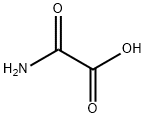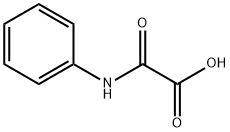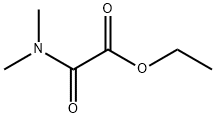Oxamic acid , >97.0%(T) , 471-47-6
Synonym(s):
Aminooxoacetic acid;Oxalic acid monoamide
CAS NO.:471-47-6
Empirical Formula: C2H3NO3
Molecular Weight: 89.05
MDL number: MFCD00008006
EINECS: 207-443-0
| Pack Size | Price | Stock | Quantity |
| 1g | RMB79.20 | In Stock |
|
| 5G | RMB187.20 | In Stock |
|
| 25G | RMB749.60 | In Stock |
|
| 100g | RMB2399.20 | In Stock |
|
| others | Enquire |
PRODUCT Properties
| Melting point: | 207-210 °C (dec.) (lit.) |
| Boiling point: | 165.08°C (rough estimate) |
| Density | 1.6193 (rough estimate) |
| refractive index | 1.4264 (estimate) |
| storage temp. | 2-8°C(protect from light) |
| solubility | DMSO (Slightly), Methanol (Slightly), Water (Slightly) |
| form | Crystalline Powder |
| pka | 1.60±0.20(Predicted) |
| color | White |
| Water Solubility | Soluble in water 108 mg/mL. |
| Merck | 14,6917 |
| BRN | 1743294 |
| InChI | InChI=1S/C2H3NO3/c3-1(4)2(5)6/h(H2,3,4)(H,5,6) |
| InChIKey | SOWBFZRMHSNYGE-UHFFFAOYSA-N |
| SMILES | C(O)(=O)C(N)=O |
| CAS DataBase Reference | 471-47-6(CAS DataBase Reference) |
| EPA Substance Registry System | Oxamic acid (471-47-6) |
Description and Uses
Oxamic acids also known to as oxalic acid monoamides have emerged as potent precursors for the generation of the carbamoyl radical. Oxamic acids can easily undergo decarboxylation through a single electron oxidation resulting in the generation of the reactive carbamoyl radical, which can then engage in diverse radical reactions or undergo a second single electron oxidation as originally unveiled by Minisci. Oxamic acids are thus versatile intermediates for the synthesis of nitrogen-containing organic molecules[1]. The oxidative decarboxylation of oxamic acids can be mediated through thermal, photochemical, electrochemical or photoelectrochemical means, generating carbamoyl radicals, which may further add to unsaturated systems to provide a broad range of important amides. Oxidative decarboxylation of oxamic acids also offers a straightforward entry for the preparation of urethanes, ureas, and thioureas.
Oxamic acid is an ozone oxidation product and is used in the synthesis of hydroxybenzimidazoles preparation as potential anti tumor agents targeting human lactate dehydrogenase A.This compound is suitable for lactate dehydrogenase (LDH) related research.
Safety
| Symbol(GHS) |  GHS07 |
| Signal word | Warning |
| Hazard statements | H315-H319-H335 |
| Precautionary statements | P261-P280a-P304+P340-P305+P351+P338-P405-P501a |
| Hazard Codes | Xi |
| Risk Statements | 36/37/38 |
| Safety Statements | 26-36 |
| WGK Germany | 3 |
| TSCA | Yes |
| HS Code | 29241990 |





